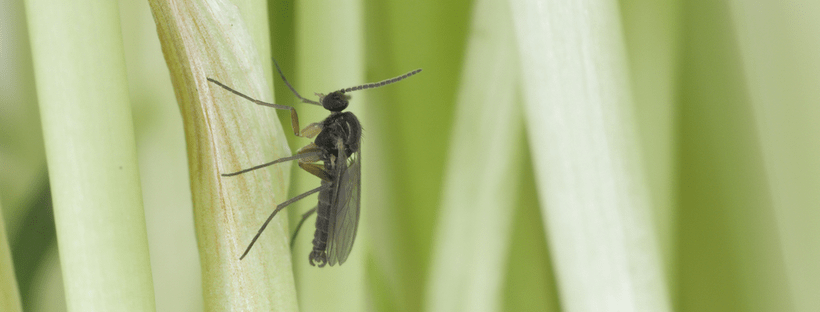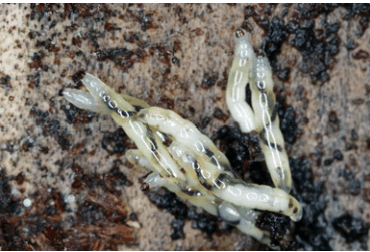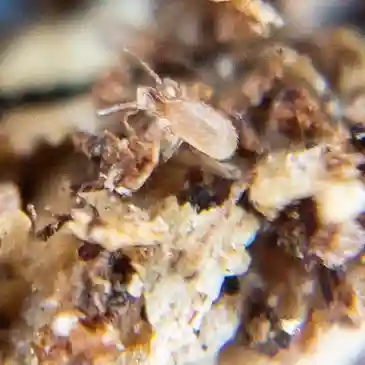Getting to Know Fungus Gnats: Tiny Troubles in Horticulture.
Comprehensive Fungus Gnat Control – PowerBugs Eco-Friendly Solutions
Are you struggling with Fungus gnats in your horticultural projects?
At PowerBugs, we provide eco-friendly, sustainable solutions to combat these pervasive pests. Discover the importance of identifying, preventing, and controlling Fungus gnats to protect your plants and promote a healthy growing environment.

Recognising Fungus gnat Infestations
Identifying Fungus Gnat Infestations
Fungus gnats, or Sciarid flies, thrive in moist and organic-rich environments.

Signs of Infestation
Watch for adult gnats flying near plants or larvae in the soil. Damage typically includes stunted growth or yellowing leaves, indicating root damage.
Fungus gnat damage
Fungus gnat larvae primarily feed on organic remains and fungi, with some species extending their diet to living plant material. The adults, attracted to humid habitats, oviposit on various microorganisms, both pathogenic and non-pathogenic.
Indirect damage arises from larvae and adults transferring fungal diseases, such as Fusarium, Botrytis, and Verticillium, from diseased to healthy plants.
Direct damage results from larvae feeding on roots, including decaying plant material, algae, and fungi in the soil. They can also feed on root hairs, rootlets, and tender root, stem, and leaf tissue. The injuries caused by feeding create entry points for pathogenic fungi. Plant death is typically localized, making young, humid, and well-watered plants particularly vulnerable.
Fungus gnats present a formidable challenge, but with PowerBugs, you have a partner in sustainable pest control. Explore our eco-friendly solutions to protect your crops and cultivate thriving, resilient environments.
Empower yourself against fungus gnat infestations. Choose PowerBugs pest control products.
Preventing Fungus gnat Infestations
Preventing Fungus Gnat Infestations in Horticulture
Optimal Watering and Soil Management
Fungus gnats can be a nuisance in horticulture settings, affecting the health of your plants. Follow these strategies to prevent fungus gnat infestations and maintain thriving horticultural spaces:
1. Optimal Watering:
- Moderation is Key: Avoid overwatering your plants, as soggy soil is a breeding ground for fungus gnats. Water your plants only when the top inch of soil is dry.
- Use Saucers: Place pots on saucers to collect excess water and prevent it from becoming a breeding site.
2. Well-Draining Soil:
- Choose the Right Mix: Use well-draining potting mixes that discourage moisture retention and fungus gnat larvae development.
3. Avoid Organic Matter Accumulation:
- Clean Surroundings: Keep the horticultural area free from fallen leaves, organic debris, and dead plant matter, which can serve as breeding sites for gnats.
4. Yellow Sticky Traps:
- Install Traps: Hang yellow sticky traps near your plants to attract and capture adult fungus gnats.
5. Biological control:
- Beneficial Mites: Consider using beneficial mites such as Hypoaspis miles in your soil, which prey on fungus gnat larvae.
6. Soil Drenches:
- Beneficial Nematodes: Consider using beneficial nematodes in your soil, which prey on fungus gnat larvae.
7. Quarantine New Plants:
- Isolate New Additions: Isolate new plants for a period before introducing them to your horticultural space to prevent potential infestations.
8. Good Plant Hygiene:
- Prune and Inspect: Regularly inspect and prune plants to remove damaged or dying parts where gnats may lay eggs.
9. Prevent Overcrowding:
- Provide Space: Avoid overcrowding your horticultural area to improve air circulation and discourage gnat infestations.
10. Educate and Monitor:
- Stay Informed: Stay informed about fungus gnat prevention and monitor your plants regularly for early signs of infestations.
By following these preventive measures, you can significantly reduce the risk of fungus gnat infestations and maintain a healthy horticultural environment where your plants can thrive.
Do You Recognise These Tiny Troublemakers in Your Soil?
Identify Your Pest


PowerBugs Predatory Mite at Work

Hypoaspis miles, answer your pest problems. These tiny warriors are nature’s allies and are here to protect your plants. Their efficacy has been well-documented over decades, making them a cornerstone of eco-friendly pest control in various agricultural settings.
Quick and Effective
Our Eco-Friendly Solutions Against Fungus Gnats
Premium Hypoaspis miles Mites – Direct from Our Insectary to Your Soil
Our top-selling predatory mite effectively controls larval populations.
Don’t let fungus gnats harm your precious plants. Contact PowerBugs today for expert fungus gnat control solutions and keep your garden thriving.
FAQs About Fungus gnats
How do I identify a fungus gnat infestation?
Fungus gnats are most easily identified by their behavior; adults are seen flying around plants or sitting on the soil surface. Larvae, which live in the soil, can be spotted as small, translucent worms with a distinctive black head, especially when the top layer of soil is disturbed.
What damage do fungus gnats cause?
While adult fungus gnats do not harm plants, the larvae feed on plant roots and organic matter in the soil, which can lead to stunted growth, yellowing of leaves, and reduced vigor in plants. Severe infestations may even kill young seedlings or cuttings.
How can I prevent fungus gnat infestations?
Prevention strategies include allowing the soil to dry out between waterings, using well-draining soil, avoiding overwatering, and covering soil surfaces with sand or gravel to deter egg-laying.
What are PowerBugs' solutions against fungus gnats?
PowerBugs offers eco-friendly biological control options for managing fungus gnats, such as Hypoaspis miles, a predatory mite that feeds on fungus gnat larvae, providing a natural way to reduce their population without harmful chemicals.
Are there any organic controls for fungus gnats?
Yes, organic control methods include using yellow sticky traps to catch adult gnats, applying Bacillus thuringiensis israelensis (Bti) to target larvae in the soil, and introducing beneficial nematodes that prey on the larvae.
Can fungus gnats affect all types of plants?
Fungus gnats can infest a wide variety of plants, but they are more commonly a problem for houseplants, seedlings, and plants grown in greenhouses due to the moist conditions.
How do fungus gnats reproduce?
Fungus gnats lay their eggs in moist soil or organic debris. These eggs hatch into larvae, which feed on organic material and plant roots before pupating and emerging as adults. The life cycle can be completed in about four weeks, depending on conditions.
How can I manage fungus gnats in a greenhouse setting?
In addition to biological controls, managing fungus gnats in greenhouses involves maintaining dry surface conditions, using screens to prevent adult entry, and practicing good sanitation to remove plant debris and reduce breeding sites.
How can I get more help with fungus gnat control?
For more information or assistance with controlling fungus gnats, contact PowerBugs directly. Our team of pest management experts is ready to help you select the best products and strategies for your specific situation, ensuring effective and eco-friendly solutions.
GET IN TOUCH
Discover the Future of Agricultural Pest Control Solutions
At PowerBugs, we’re not just selling products; we’re offering a sustainable and eco-friendly solution to pest control. Join us in making a positive change in the world of agriculture. Explore our range of beneficial mites today and take the first step towards a greener and more prosperous future.
